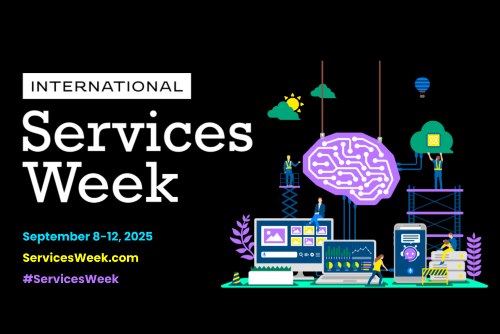Q&A: The state of the services industry

I recently sat down with Rob Harrison, who oversees International Business at Certinia, and asked him a few questions about the state of the services industry and how his customers are able to navigate its ever-changing complexities. A common theme: a need for innovation & automation.
Rob, at Certinia most of our customers are services businesses. You have been at Certinia for three months now, in that time how do you see that services organizations are performing in the current economy?
Yes, I have been here for a few months now and during that time I have tried to meet with as many customers as possible. As far as the services economy is concerned, I am happy to report that things are really good. We’re hearing from our analyst community that services organizations are seeing impressive growth, often around 10, 12 to 15%. This sector is expanding at twice the rate of the overall GDP, indicating the services economy is here to stay. It’s everywhere.
That strong growth mindset was one of the big takeaways from our inaugural Global Service Dynamics Report, where 82% of services organizations surveyed increased their services team size in 2023, with even more companies – 85% – planning to grow their teams in 2024.
So for these successful, growing services companies, what do you see as the secrets for success?
We are firm believers that success hinges on trust. If you can deliver for your customers with reliability and certainty then they will trust you as a business partner and continue to buy from you. In the professional services industry, establishing trust at every interaction is crucial, which grants you the permission to sell. This involves ensuring accuracy and promptness from the initial quote to the final bill. If customers find your processes seamless, transparent and reliable, it opens up further sales opportunities. Trust me. 🙂
How are companies managing this?
Frankly many services organizations still struggle here. The primary issue is the absence of the right tools for achieving the necessary precision and timeliness – which in turn compromises that trust. I continue to be surprised by the number of companies, some of them quite large, that still rely on Excel to run their professional services business! We see it time and time again, spreadsheets are simply insufficient for today’s business scale. Automation is essential to attain the accuracy and timeliness that foster customer trust. Also, let’s think about data. In order to make the best decisions for the future success of your business, you probably shouldn’t be relying on a plethora of fragmented, out of date spreadsheets.
What common challenges do services businesses face today?
It really varies. We see that big global service integrators (GSIs) are all about growth. They love any tools and automation that can help them grow. Resource management is a big deal too—getting the right people, at the right bill rate, on the right jobs quickly. They want to look at a major project and make rapid adjustments to optimise their profit. But they want to do that in hours, not days, all while keeping their promises to customers. Better automation helps them do that.
For midsized companies, they want to use the best practices of larger firms without losing their agility, nimbleness, and friendly customer service. Automation is key for them too and resource utilisation is always a top priority. But they also face a lot of financial pressure now that money isn’t as cheap as it was. These companies need to fix revenue leaks and be quicker, more efficient, and more effective in selling.
For services teams within product companies, they aim to be more than just another form of customer support, solely interested in brand protection—they are increasingly looking to act and operate as profit centers as well. To do this, they need to deliver great experiences that keep customers loyal while staying profitable.
You’ve highlighted automation several times. How important is that for today’s services organizations?
Historically, services organizations have been slow to adopt automation. As I mentioned previously the #1 dominant product today is still Microsoft Excel. But the good news is that these same organizations are starting to realize that spreadsheets are no longer practical for scale. Accurate financial reporting is vital, and mistakes can have serious repercussions. Needless to say, the opportunities for improvement are ripe. In that same Global Service Dynamics Report, data showed that efficiency is top of mind for executives when measuring success. Yet, half of companies reported having a resource utilization rate of 66% or worse, so the potential for improvement is very significant. This rings true in the data, as less than half of service organizations indicated use of a commercial Professional Services Automation (PSA) solution, despite the documented impacts such applications have on enhancing efficiency, profitability, workload balance, and overall employee and customer satisfaction. Innovation and automation are critical if companies are going to achieve sustainable improvements in business performance that will keep them ahead of the competition.
Great stuff Rob, thank you for sharing your insights. It’s been a pleasure.
Recent Articles
Maximize your Salesforce investment with Certinia







